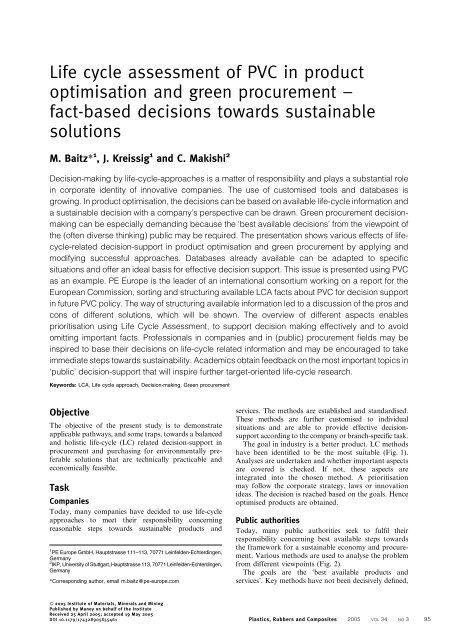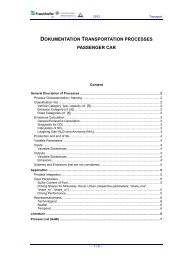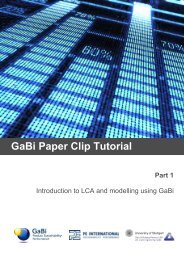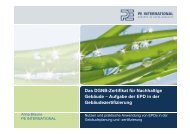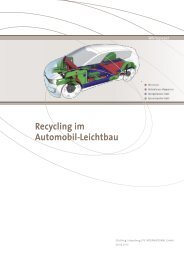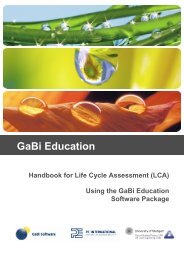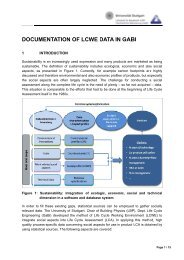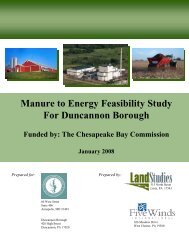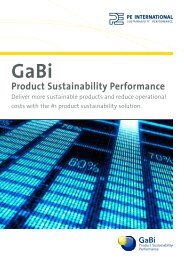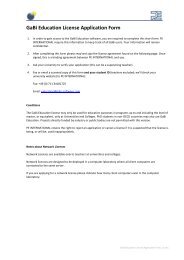here - GaBi Software
here - GaBi Software
here - GaBi Software
Create successful ePaper yourself
Turn your PDF publications into a flip-book with our unique Google optimized e-Paper software.
Life cycle assessment of PVC in product<br />
optimisation and green procurement –<br />
fact-based decisions towards sustainable<br />
solutions<br />
M. Baitz* 1 , J. Kreissig 1 and C. Makishi 2<br />
Decision-making by life-cycle-approaches is a matter of responsibility and plays a substantial role<br />
in corporate identity of innovative companies. The use of customised tools and databases is<br />
growing. In product optimisation, the decisions can be based on available life-cycle information and<br />
a sustainable decision with a company’s perspective can be drawn. Green procurement decisionmaking<br />
can be especially demanding because the ‘best available decisions’ from the viewpoint of<br />
the (often diverse thinking) public may be required. The presentation shows various effects of lifecycle-related<br />
decision-support in product optimisation and green procurement by applying and<br />
modifying successful approaches. Databases already available can be adapted to specific<br />
situations and offer an ideal basis for effective decision support. This issue is presented using PVC<br />
as an example. PE Europe is the leader of an international consortium working on a report for the<br />
European Commission, sorting and structuring available LCA facts about PVC for decision support<br />
in future PVC policy. The way of structuring available information led to a discussion of the pros and<br />
cons of different solutions, which will be shown. The overview of different aspects enables<br />
prioritisation using Life Cycle Assessment, to support decision making effectively and to avoid<br />
omitting important facts. Professionals in companies and in (public) procurement fields may be<br />
inspired to base their decisions on life-cycle related information and may be encouraged to take<br />
immediate steps towards sustainability. Academics obtain feedback on the most important topics in<br />
‘public’ decision-support that will inspire further target-oriented life-cycle research.<br />
Keywords: LCA, Life cycle approach, Decision-making, Green procurement<br />
Objective<br />
The objective of the present study is to demonstrate<br />
applicable pathways, and some traps, towards a balanced<br />
and holistic life-cycle (LC) related decision-support in<br />
procurement and purchasing for environmentally preferable<br />
solutions that are technically practicable and<br />
economically feasible.<br />
Task<br />
Companies<br />
Today, many companies have decided to use life-cycle<br />
approaches to meet their responsibility concerning<br />
reasonable steps towards sustainable products and<br />
1<br />
PE Europe GmbH, Hauptstrasse 111–113, 70771 Leinfelden-Echterdingen,<br />
Germany<br />
2<br />
IKP, University of Stuttgart, Hauptstrasse 113, 70771 Leinfelden-Echterdingen,<br />
Germany<br />
*Corresponding author, email m.baitz@pe-europe.com<br />
services. The methods are established and standardised.<br />
These methods are further customised to individual<br />
situations and are able to provide effective decisionsupport<br />
according to the company or branch-specific task.<br />
The goal in industry is a better product. LC methods<br />
have been identified to be the most suitable (Fig. 1).<br />
Analyses are undertaken and whether important aspects<br />
are covered is checked. If not, these aspects are<br />
integrated into the chosen method. A prioritisation<br />
may follow the corporate strategy, laws or innovation<br />
ideas. The decision is reached based on the goals. Hence<br />
optimised products are obtained.<br />
Public authorities<br />
Today, many public authorities seek to fulfil their<br />
responsibility concerning best available steps towards<br />
the framework for a sustainable economy and procurement.<br />
Various methods are used to analyse the problem<br />
from different viewpoints (Fig. 2).<br />
The goals are the ‘best available products and<br />
services’. Key methods have not been decisively defined,<br />
ß 2005 Institute of Materials, Minerals and Mining<br />
Published by Maney on behalf of the Institute<br />
Received 25 April 2005; accepted 19 May 2005<br />
DOI 10.1179/174328905X55461 Plastics, Rubbers and Composites 2005 VOL 34 NO 3 95
Baitz et al. Life cycle assessment of PVC in product optimisation and green procurement<br />
1 LC methods for decision support in industry<br />
but LC methods play a significant part. During or after<br />
an analysis, the need to cover more aspects is pushed by<br />
the public (pressure) or sought by the authorities<br />
(responsibility). Different methods are used to cover<br />
different aspects. Hence the problem of completing the<br />
analysis is twofold. The consolidation of information<br />
from different methods is difficult and public stakeholders<br />
are obstructing in claiming to integrate further<br />
aspects with further methods. Even if the analysis can be<br />
completed, the next problem in decision-making arises; a<br />
prioritisation step is difficult owing to diverse public<br />
opinions about the importance of different aspects.<br />
These aspects hinder decision-making and slow down<br />
optimisation steps. Nevertheless, ‘fact-based sustainable<br />
decisions’ are also needed.<br />
Approach and pathways: example pvc<br />
The European Commission is tackling the task of basing<br />
decisions on holistic information, <strong>here</strong> in the case of<br />
PVC. 1 Apart from an approach based on PVC and<br />
additives in waste management, the question of potential<br />
substitution for certain PVC applications was raised.<br />
Comparisons at the material production level are<br />
insufficient since significant environmental impacts or<br />
benefits of materials may occur during the use and<br />
recycling stages. T<strong>here</strong>fore, only a comparison considering<br />
the entire life cycle of a material can show the full<br />
picture. LCA is a powerful tool for the analysis and<br />
optimisation of a product over its life cycle and is<br />
effective in broadly implementing life cycle thinking.<br />
The EU Commission concludes for Integrated Product<br />
Policy (IPP): LCAs provide the best framework for<br />
assessing the potential environmental impacts of products<br />
currently available. They are t<strong>here</strong>fore an important<br />
support tool for IPP. 2<br />
T<strong>here</strong>fore, Life Cycle Assessments, preferably according<br />
to ISO 14040 ff (which is the International Standard<br />
on LCA and t<strong>here</strong>fore guarantees a certain quality of<br />
results), are of primary interest. Additionally, the level of<br />
current optimisation of a material should be considered.<br />
A material, which has been optimised continually over<br />
time, may show a lower potential for further improvement<br />
than a less optimised material. Under these<br />
circumstances, PE Europe was the leader of an international<br />
consortium composed of PE Europe GmbH and<br />
IKP University of Stuttgart (Germany), Randa Group<br />
(Spain) and IPU (Denmark) performing the study on a<br />
European level (EU 15) 1 for the European Commission.<br />
The PVC study is a joint project of the Enterprise and<br />
Environment Directorate-Generals. It follows a request<br />
of the European Parliament in its resolution on the PVC<br />
Green Paper of 2000. 3<br />
96 Plastics, Rubbers and Composites 2005 VOL 34 NO 3<br />
2 Various methods to cover ‘all’ aspects in public<br />
Initially, an overview of various effects over many<br />
interrelated and influencing processes in the LC was<br />
important: an adequate method was used and the<br />
conviction to stay with it as far as possible led to an<br />
overview of the aspects, rather than obtaining diffuse<br />
results as a result of varying methods. In summary, all<br />
detected studies are now documented in a comprehensive<br />
catalogue and the procedure used to choose and<br />
assess the most relevant studies follows some basic rules:<br />
(i) Priority settings of the steering committee are<br />
applied after an overview of all available studies<br />
is obtained.<br />
(ii) A streamlined ad<strong>here</strong>nce check with existing<br />
international standards is performed and documented.<br />
(iii) Whether the key features of a quality-LCA are<br />
included is checked.<br />
(iv) A study is further characterised even if the<br />
priority settings of the steering committee are<br />
not directly matched; the study addresses an<br />
important aspect not yet covered, or the study<br />
has been ranked as important in relation to the<br />
goal of the study.<br />
To draw decisions on important and relevant topics, the<br />
application and use of the analysed subject must be<br />
clarified. Figure 3 shows the principal procedure.<br />
The building and construction sector is by far the most<br />
important PVC sector. It comprises almost 50% of<br />
applications in relation to the applied mass flow. The share<br />
of PVC mass used in this application is the highest in the<br />
matrix and the market share of PVC in relation to<br />
competing materials is most often ‘major’. Window frames,<br />
claddings, sheets and conduits/shutter/rails/skirts are all<br />
part of this application field, as well as flooring (including<br />
sport flooring). Another important PVC application is<br />
piping. Approximately 12% of applied PVC goes into<br />
wastewater and rainwater pipes, and the competitive<br />
market share for this application is considered ‘major’.<br />
The sector of electric and electronic equipment also<br />
plays an important role. Cable applications comprise<br />
approximately 11% of the market in terms of all PVC<br />
mass, and PVC holds a major market share in<br />
comparison to competing materials.<br />
For toys and sports goods, only inflatable products<br />
play a role. This application accounts for approximately<br />
3% of the PVC mass and a major market share relative<br />
to its competitors.<br />
Within consumer goods, some major market shares, in<br />
relation to the competitors, are reported, but mass<br />
streams for these applications are rather small (shoes<br />
and office equipment show some relevance).
3 Information flow within assessment procedure 1<br />
In terms of applied PVC mass, the packaging sector<br />
plays a role, w<strong>here</strong>as the market share in relation to its<br />
competitors is medium to small.<br />
In the transport sector (including cars, trucks, yachts<br />
and trains), PVC is mostly used in small amounts for<br />
numerous applications like plastisol sealing or underbody<br />
protection, body parts, tarpaulins, dashboards,<br />
artificial leather, cable harnesses, foams, fenders and<br />
seat coverings. In some applications within the transport<br />
sector, PVC is the major material in comparison to<br />
competitors, and plastisols and artificial leather play a<br />
larger role in terms of applied mass share.<br />
Within medical applications, PVC plays a major role,<br />
but the mass streams are small.<br />
Agricultural applications are negligible in this context.<br />
Some traps<br />
While gathering information for public decision support,<br />
some traps may be met. Some stakeholders will<br />
always claim that a certain method may not cover a<br />
certain aspect.<br />
Further, it is obvious that decisions have to be based<br />
on solid information. Nevertheless to obtain solid<br />
information, diffuse information has to be neglected at<br />
first in order to get an initial overview. So the goal and<br />
scope of the decision support has to be defined very<br />
carefully, otherwise the analysis gets caught up in<br />
irrelevant information. If important aspects show up<br />
during the analysis, a deeper assessment with other<br />
methods on specific tasks can be carried out once an<br />
overview has been established. It is obvious that the<br />
complete life-cycle has to be considered. But it is also<br />
Baitz et al. Life cycle assessment of PVC in product optimisation and green procurement<br />
common sense that not all parts of the complete lifecycle<br />
must be analysed with the same degree of detail:<br />
concentrate on relevant processes but neglect or simplify<br />
only processes that you know about in detail (‘unfortunately’,<br />
some experience is needed <strong>here</strong>).<br />
Conclusions<br />
Study-related conclusions<br />
The following general conclusions can be drawn on PVC<br />
and its life cycle:<br />
(i) LCA comparisons should be undertaken at the<br />
application level rather than at the material<br />
level. Depending on the type of product, the<br />
environmental impact during use or after endof-life<br />
can be even more important than the<br />
environmental impact of material production<br />
(e.g. fuel saving lightweight parts in automotive<br />
applications or use phase effects of the cleaning<br />
of flooring materials). Approximately 100<br />
LCAs related to PVC have been identified, with<br />
only 30 making comparisons at the application<br />
level.<br />
(ii) LCAs are strongly goal- and scope-dependent.<br />
T<strong>here</strong>fore, two studies on the same product<br />
system may give different conclusions. LCAs do<br />
not aim to evaluate the effects of exposure and<br />
hazard-related data in the way risk assessments<br />
do. LCAs identify the important environmental<br />
aspects and stages over the life cycle and risk<br />
assessments analyse exposure and hazardrelated<br />
information. Both can be used within a<br />
toolbox.<br />
(iii) Within the PVC life cycle chain, the production<br />
of intermediates, particularly the processes from<br />
the extraction of crude oil and rock salt up to<br />
VCM production, plays a major role in environmental<br />
impact.<br />
(iv) From a PVC life cycle perspective, the production<br />
of stabilisers and plasticisers plays a<br />
significant role, w<strong>here</strong>as the production of<br />
pigments offers a comparatively low optimisation<br />
potential, because of the small volumes<br />
used.<br />
(v) Some new technologies exist, e.g. mechanical<br />
recycling based on selective dissolution for<br />
recycling PVC in an economically feasible<br />
way. However, currently only a small amount<br />
of PVC post-consumer waste is being recycled.<br />
Incineration, in conjunction with municipal<br />
waste disposal, is a simple option that allows<br />
for the partial recovery of energy and substances,<br />
if state-of-the-art technology is applied.<br />
(vi) Regarding the positive effects of increasing<br />
recycling rates, mechanical recycling (or material<br />
recycling), which loops the material back<br />
directly into new life cycles, substitutes, to a<br />
certain extent, the processes of resource extraction,<br />
intermediate production and granulation/<br />
polymerisation during the production of virgin<br />
material. Chemical recycling (feedstock recycling)<br />
is another option for recycling PVC into<br />
another life cycle.<br />
(vii) In contrast to some metals, the recycling market<br />
for plastics, and t<strong>here</strong>fore the demand in<br />
Plastics, Rubbers and Composites 2005 VOL 34 NO 3 97
Baitz et al. Life cycle assessment of PVC in product optimisation and green procurement<br />
secondary material, has not yet been established<br />
in an adequate way. Nevertheless, today and in<br />
the near future, a mix of mechanical and<br />
chemical recycling pathways and state-of-theart<br />
disposal routes is seen as the most favourable<br />
way to optimise the environmental impact<br />
of PVC and competing materials.<br />
(viii) The user will not accept recycled products with<br />
lower optical or aesthetic quality (colour, surface<br />
quality), even if the technical quality<br />
(mechanical properties, durability) is the same.<br />
This is especially true for building, electronic<br />
and automotive products.<br />
The most important applications for PVC are in the<br />
building and construction sector (windows/shutters,<br />
sheets, flooring and pipes), the electric and electronic<br />
equipment sector (predominantly cables), the transport<br />
sector (plastisols, artificial leather, dashboards, structural<br />
parts) and the packaging sector (non-beverage<br />
packaging). A remarkable amount of LCA information<br />
is available for building materials and products, but a<br />
strong dependence remains on the specific results and<br />
the goal and scope of the studies case-by-case.<br />
The main findings concerning sector and application<br />
specific LCAs of PVC and its competitors are:<br />
(i) For windows, one of the most important PVC<br />
applications, the available studies conclude that<br />
t<strong>here</strong> is no ‘winner’ in terms of a preferable<br />
material since most of the studies conclude that<br />
none of the materials has an overall advantage<br />
for the standard impact categories. The most<br />
promising potential for lowering environmental<br />
impacts of windows is expected through<br />
optimisation of the design. T<strong>here</strong>fore the choice<br />
of material is of rather minor importance, as<br />
long as the material can provide the required<br />
system quality for the window.<br />
(ii) Most flooring application studies conclude that<br />
linoleum has comparable or slightly fewer<br />
environmental impacts compared to PVC flooring<br />
of equivalent quality in the production<br />
phase. T<strong>here</strong> is little LCA information about<br />
carpeting, a main competitor for flooring<br />
applications.<br />
(iii) For roofing applications, studies conclude that<br />
a higher quality of the systems (thermal<br />
conductivity per thickness of roofing sheet<br />
layers) as well as the accuracy of the laying<br />
and maintenance processes has the greatest<br />
influence on the reduction of environmental<br />
impact. The studies report that polymer solutions<br />
tend to have lower environmental impacts<br />
than bitumen systems owing to the heavier<br />
construction of the bitumen solution.<br />
(iv) The results for pipes are very heterogeneous.<br />
Some studies see clear advantages for concrete<br />
and fibre cement pipes, some report clear<br />
advantages for polymer pipes such as PVC<br />
and PE, some conclude that the material plays<br />
no role as long as no cast iron is chosen.<br />
(v) The only toy applications requiring significant<br />
amounts of PVC are applications such as<br />
inflatable toys, paddling pools and rubber<br />
boats/rafts. The potential risks associated with<br />
the misuse of toys (e.g. ingestion, sucking or<br />
98 Plastics, Rubbers and Composites 2005 VOL 34 NO 3<br />
chewing) are of particular concern. However, an<br />
LCA cannot analyse these risks properly; t<strong>here</strong>fore,<br />
these concerns should be addressed using<br />
other tools, such as risk assessment.<br />
(vi) The relevance of PVC in packaging is decreasing.<br />
PVC bottles tend to have comparable impacts<br />
to those of PET bottles; however, the market<br />
share of PVC bottles in Europe is now minor.<br />
(vii) In the transport sector (including automotive),<br />
many comparative LCA studies including PVC<br />
alternatives have been performed. However,<br />
these studies are confidential and were not<br />
available for analysis in the present study.<br />
(viii) PVC cable does not seem to have significant competitors<br />
in many cable applications; t<strong>here</strong>fore<br />
few PVC cable LCA studies exist. Recycling<br />
processes have been in place for some time as<br />
a result of the high economic value of the<br />
recovered copper and aluminium.<br />
No comparative LCA studies exist for materials used in<br />
medical applications, and little environmental optimisation<br />
in medical products has taken place thus far.<br />
Taking this into consideration, together with the large<br />
amount of waste produced by hospitals as a result of<br />
waste medical products, the potential for comparative<br />
LCA studies identifying methods for improvement is<br />
expected to be high.<br />
General conclusions<br />
Public green procurement can come to ‘fact-based<br />
sustainable decisions’ – even in adequate timeframes –<br />
if suitable methods like life-cycle approaches are applied<br />
in the early stage of decision-making.<br />
Many aspects can be included comparatively easily,<br />
providing a holistic and comprehensive overview of the<br />
most relevant aspects from an environmental, technical<br />
and economic viewpoint.<br />
If other important topics remain or are identified<br />
within an LCA which are difficult to analyse in detail<br />
with an LCA, other methods like risk assessment can be<br />
used to focus on the relevant aspects of specific<br />
applications that have been identified, rather than using<br />
them in parallel for all applications (effective cooperation<br />
rather than redundant work).<br />
This kind of ‘fact-based sustainable decision-making’<br />
can be successfully applied to other public decision and<br />
policy making as well – and may also even enrich certain<br />
Directives such as the Directive on ‘End-of life vehicles’. 4<br />
Acknowledgements<br />
Based on a presentation at the 9th International PVC<br />
Conference held in Brighton, UK, in April 2005.<br />
References<br />
1. ‘Life cycle assessment of PVC and of principal competing<br />
materials’, DG Enterprise and DG Environment, EU<br />
Commission. Study available at: http://europa.eu.int/comm/<br />
enterprise/chemicals/sustdev/pvc.htm<br />
2. ‘Building on environmental life cycle thinking’, 18 March 2003,<br />
Communication from the Commission to the Council and the<br />
European Parliament Integrated Product Policy.<br />
3. Green Paper on ‘Environmental issues of PVC’, COM (2000) 469,<br />
26 July 2000, EU Commission.<br />
4. ‘End-of-life vehicles’, Directive 2000/53/EC of the European<br />
Parliament and of the Council of 18 September 2000, EU Commission.


